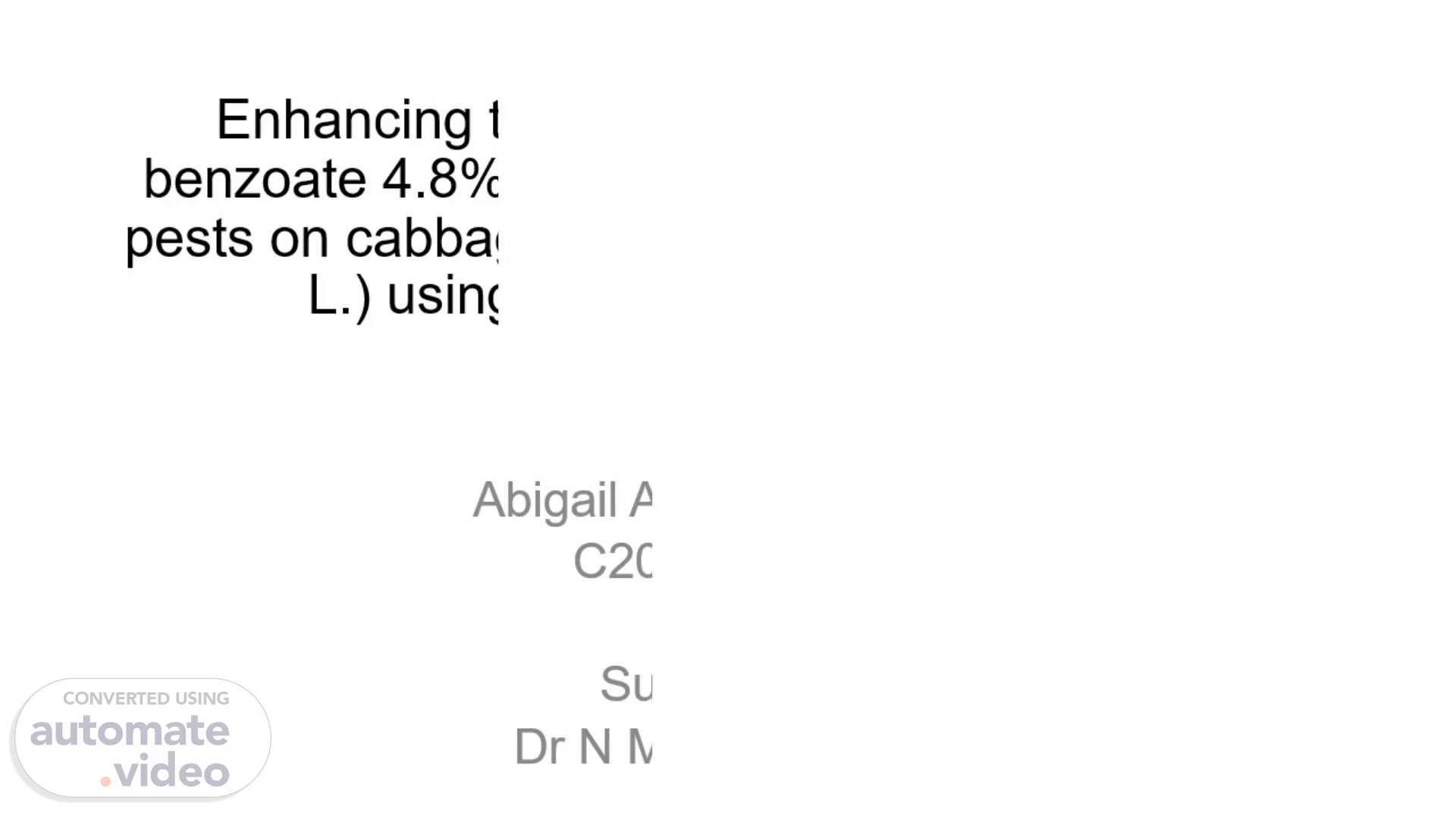
Enhancing the effectiveness of emamectin benzoate 4.8% + acetamiprid 6.4% in controlling pests on cabbage (Brassica oleracea var. capitata L.) using a silicone-based adjuvant
Scene 1 (0s)
Enhancing the effectiveness of emamectin benzoate 4.8% + acetamiprid 6.4% in controlling pests on cabbage (Brassica oleracea var. capitata L.) using a silicone-based adjuvant.
Scene 2 (6s)
BACKGROUND OF STUDY. Cabbage (Brassica oleracea var. capitata Linnaeus) production in Zimbabwe has been slightly fluctuating for the past five years due to its ability to be a magnet to certain pests (Gumbeze et al., 2023). Diamondback moth (Plutella xylostella) and aphids (Brevicoryne brassicae Linnaeus) are the most damaging pests of cabbage. These pests have a potential of causing 52.5% yield loss if not controlled well (Sharma & Katlam, 2023). Control expenses and yield loss for DBM alone are expected to be between $4 and $5 billion per year globally..
Scene 3 (31s)
BACKGROUND OF STUDY. Resurgence, secondary pest outbreaks and resistance of these pests have increased with the continuous use of insecticides. In response to the pest’s resistance to pesticides, farmers resort to using higher dosages of pesticides in order to achieve effective control. Cuticular wax in crops like cabbage affects the contact bioavailability of active ingredients of pesticides. By improving the physical-chemical properties of the spray solution, an silicone based adjuvant can enhance spread, adhesion and penetration of the active ingredients to the waxy cuticle..
Scene 4 (55s)
PROBLEM STATEMENT. Diamondback moths and cabbage aphids have developed resistance to many active ingredients, and commercial products. Reduced pesticide efficacy on waxy crops resulted to usage of high pesticide dosages to compensate for pesticide losses due to hydrophobic waxy surfaces High dosages hasten the development of resistances, resulting in poor pest control thus low yields and economic returns..
Scene 5 (1m 13s)
JUSTIFICATION. Previous researches focused on mainly evaluating effect of silicone based products on other groups of insecticides in cabbage. There is insufficient knowledge on some groups of insecticides e.g. Avermectin and Neonicotinoid under field condition. The research will shed more light on enhancing cabbage yield through use of optimum dosage rate pesticide and adjuvants by reducing DBM and aphid resistance, improving efficacy, and minimizing environmental pollution..
Scene 6 (1m 33s)
OBJECTIVES. Overall objective To evaluate the effectiveness of silicone-based spreader and activator in enhancing the efficacy of Spike extra 11.2 EC® in controlling aphids and diamond back moth in cabbage. Specific objectives To determine the effect of integrated application of silicon based spreader and activator at different dosages, and spike extra 11.2 EC® on population of diamondback moth and aphids in cabbages cabbage leaf damage due to diamondback moth and aphids cabbage yield.
Scene 7 (2m 47s)
HYPOTHESIS. Addition of silicon based spreader and activator to a spray solution containing spike extra 11.2 EC® has no effect on the population of diamondback moth and aphids in cabbages the population of diamondback moth and aphids in cabbages cabbage yield..
Scene 8 (3m 1s)
SITE DESCRIPTION. CUT farm in Mashonaland west of Zimbabwe during 2023-2024 cropping season. Natural region IIb Mean annual rainfall 700 - 1000 mm. Temperature range 24.5⁰C -10.3⁰C Geographical location: 30⁰ 12′S, 17⁰ 21′E ( Mashavakure, 2020) Altitude 1140m Soil type: Inert clays soils Main activities are crop production and livestock production..
Scene 9 (3m 40s)
Experimental Design and Treatments. The study will be conducted using Randomized Complete Block Design with six treatments replicated four times.
Scene 10 (4m 11s)
AGRONOMIC PRACTICES. Inter-row spacing of 80 cm and in-row spacing of 40 cm Plot dimension: 6 rows (3.9 m) x 5 m (thus 19.5 m2) Total land area inclusive pathways: 535.5 m2 Land will be disk ploughed before the plots are marked. Compound C (5 15: 15: 12) fertilizer will be applied as a basal fertilizer at a rate of 600 kg ha-1 Ammonium nitrate (35.5% N) fertilizer will be applied at two and eight WAE at a rate of 450 kg ha-1, while potassium nitrate (13: 0: 45) will be applied at six WAE at a rate of 250 kg ha-1. From three WAE Spike extra will be sprayed using a knapsack sprayer with a nozzle pressure of 2.5 bars.
Scene 11 (5m 10s)
DATA COLLECTION. Net plot of three central rows and randomly selecting five plant Pest population: Recording of the number of DBM larvae before spraying and at 3, 7,14 days after spraying Manual aphids counting on of outer three leaves of the cabbage plants Pest damage. The number of leaves and plants attacked by diamond back moth (DBM), and aphid will be counted. At harvesting, insect damaged wrapper leaves on the heads will be removed and counted and net weighed. Used to calculate percentage damage for each plot. Cabbage yield Cabbage head to be weighed before and after trimming of damaged leaves using a scale.
Scene 12 (6m 3s)
STATISTICAL ANALYSIS. Data will be analysed using two-way analysis of variance using Gen-stat Statistical package (18th edition). Where significant treatment means are detected, mean separation will be done using the least significant difference (LSD) at the significance level of 5%..
Scene 13 (6m 17s)
EXPECTED OUTCOMES. This research is expected to come out with standard recommendations, procedures and dosage rates for a silicone based activator and spreader resulting to enhanced pesticide efficiency Reduced DBM and aphids resistance Minimum environmental pollution High cabbage yield.
Scene 14 (6m 30s)
WORK PLAN.
Scene 15 (6m 39s)
BUDGET.
Scene 16 (6m 54s)
REFERENCES. Balkaya, A., Yanmaz, R., Apaydin, A., & Kar, H. (2005). Morphological characterisation of white head cabbage (brassica oleracea var. Capitata subvar. alba) genotypes in Turkey. New Zealand Journal of Crop and Horticultural Science, 33(4), 333–341. https://doi.org/10.1080/01140671.2005.9514367 Crafts, A. S., & Foy, C. L. (1962). The chemical and physical nature of plant surfaces in relation to the use of pesticides and to their residues..
Scene 17 (7m 0s)
ACKNOWLEDGEMENT. Windmill Pvt Limited Chinhoyi University of Technology Supervisor Coordinator Colleagues The Lord.
Scene 18 (7m 8s)
Thank you.